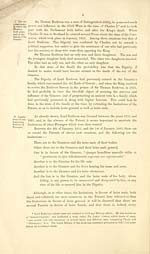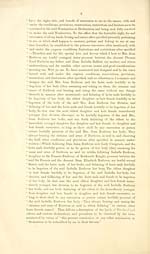Memorial as to the Ruthven peerage
(9) Page 5
Download files
Complete book:
Individual page:
Thumbnail gallery: Grid view | List view

variety of limitation, from the mere liferent of the Grantee himself to the
delegation of the sovereign power of nominating and providing heirs to a
Peerage. So far from females being excluded from succeeding to Peerages
at the period in question, two of the Patents expressly provide for their
inheriting the Earldoms thereby created.
The right of nominating successors to th e Barony of Rutherford contained
in the Patent of Creation in 1661 was not new. Such a power of nomination
had been conferred soon after the Union of the Crowns of England and Scotland
and it was continued down to the Union of these Kingdoms, when Peers of
Scotland ceased to be created.
One of the earliest instances of this right of nomination occurs in the
Patent of the Barony of Hume of Berwicke in favour of Sir George Hume, who
was afterwards created Earl of Dunbar. That Patent was granted by James I
of England on the 7th of July, 1604, to the Grantee and his heirs general for
ever, with the privilege of nominating heirs and assignees to the dignity from
among his cousins and relatives by Settlement or last Will.
Similar rights of nomination were given in subsequent Patents by
James VI and the successive Sovereigns, down to and including Queen Anne,
who, in the year 1707, conferred this power in re-grants to the Earl of
Kilmarnock and to the Earl of Stair. One of the substitutions in the re-grant
of the latter title is in these tprms : " To such person or persons descended of
" the said James Viscount of Stair as the said Earl should nominate and
" appoint by writing under his hand, at any time during his life, — and failing
" such nomination or the persons so nominated," &c.
The Estates of Freeland, Kirktonmailar, and others, which belonged to III. Limita-
Sir Thomas Buthven at the time of his Creation as Lord Ruthven, between o" 1 ^ .' le
1651 and 1661, were all limited and descendible to heirs and assignees, these, Estates.
of course, including females. After his Creation as Lord Ruthven, and a few
years before his death, he obtained a Crown Charter of part of his lands, — and
it is probable that he had intended to execute an Entail regulating the
succession after his death, in the same terms, it will be shown, as his son did,
so soon as he had completed his feudal title as heir to his father in the Territorial
subjects.
Thomas, the first Lord, died in 1671. David, his son and successor, as
second Lord, made up titles to different portions of the lands in the years
1673-1674. His infeftment, proceeding on a Crown Charter, in the lands of
Mailar, is dated 20th May, 1674. As soon as these titles were completed, and
before infeftments in other parts of the Estate were expede, David Lord Ruthven
executed, of. this date, a nomination and designation of heirs to succeed to him 26th Octo-
in all his " lands, liveing and estate." " er > 1674.
This nomination proceeds on the following narrative : " Me David Lord
" Ruthven of Frieland heritable proprietor of the lands and others under
" written with the pertinents — Forasmeikle as my lands, liveing and estate after
" specified are come to my hands be derivation from my carefull predecessors,
" and that be my Infeftments thereof standing in my person I have full
" privilege and power, at any time during my lifetime, to nominate and designe
" be my declaration subscrived with my hand in presence of famous witnesses
" the person or persons, ane or mae, whom I would have to succeed to me therein
" successive ane after another (failing heirs lawfully to be begotten of my own
" bodie) and that the persons, ane or mae, so to be designed as said is, shall
i
Q
>
delegation of the sovereign power of nominating and providing heirs to a
Peerage. So far from females being excluded from succeeding to Peerages
at the period in question, two of the Patents expressly provide for their
inheriting the Earldoms thereby created.
The right of nominating successors to th e Barony of Rutherford contained
in the Patent of Creation in 1661 was not new. Such a power of nomination
had been conferred soon after the Union of the Crowns of England and Scotland
and it was continued down to the Union of these Kingdoms, when Peers of
Scotland ceased to be created.
One of the earliest instances of this right of nomination occurs in the
Patent of the Barony of Hume of Berwicke in favour of Sir George Hume, who
was afterwards created Earl of Dunbar. That Patent was granted by James I
of England on the 7th of July, 1604, to the Grantee and his heirs general for
ever, with the privilege of nominating heirs and assignees to the dignity from
among his cousins and relatives by Settlement or last Will.
Similar rights of nomination were given in subsequent Patents by
James VI and the successive Sovereigns, down to and including Queen Anne,
who, in the year 1707, conferred this power in re-grants to the Earl of
Kilmarnock and to the Earl of Stair. One of the substitutions in the re-grant
of the latter title is in these tprms : " To such person or persons descended of
" the said James Viscount of Stair as the said Earl should nominate and
" appoint by writing under his hand, at any time during his life, — and failing
" such nomination or the persons so nominated," &c.
The Estates of Freeland, Kirktonmailar, and others, which belonged to III. Limita-
Sir Thomas Buthven at the time of his Creation as Lord Ruthven, between o" 1 ^ .' le
1651 and 1661, were all limited and descendible to heirs and assignees, these, Estates.
of course, including females. After his Creation as Lord Ruthven, and a few
years before his death, he obtained a Crown Charter of part of his lands, — and
it is probable that he had intended to execute an Entail regulating the
succession after his death, in the same terms, it will be shown, as his son did,
so soon as he had completed his feudal title as heir to his father in the Territorial
subjects.
Thomas, the first Lord, died in 1671. David, his son and successor, as
second Lord, made up titles to different portions of the lands in the years
1673-1674. His infeftment, proceeding on a Crown Charter, in the lands of
Mailar, is dated 20th May, 1674. As soon as these titles were completed, and
before infeftments in other parts of the Estate were expede, David Lord Ruthven
executed, of. this date, a nomination and designation of heirs to succeed to him 26th Octo-
in all his " lands, liveing and estate." " er > 1674.
This nomination proceeds on the following narrative : " Me David Lord
" Ruthven of Frieland heritable proprietor of the lands and others under
" written with the pertinents — Forasmeikle as my lands, liveing and estate after
" specified are come to my hands be derivation from my carefull predecessors,
" and that be my Infeftments thereof standing in my person I have full
" privilege and power, at any time during my lifetime, to nominate and designe
" be my declaration subscrived with my hand in presence of famous witnesses
" the person or persons, ane or mae, whom I would have to succeed to me therein
" successive ane after another (failing heirs lawfully to be begotten of my own
" bodie) and that the persons, ane or mae, so to be designed as said is, shall
i
Q
>
Set display mode to:
![]() Universal Viewer |
Universal Viewer | ![]() Mirador |
Large image | Transcription
Mirador |
Large image | Transcription
Images and transcriptions on this page, including medium image downloads, may be used under the Creative Commons Attribution 4.0 International Licence unless otherwise stated. ![]()
| Histories of Scottish families > Memorial as to the Ruthven peerage > (9) Page 5 |
|---|
| Permanent URL | https://digital.nls.uk/95642539 |
|---|
| Description | A selection of almost 400 printed items relating to the history of Scottish families, mostly dating from the 19th and early 20th centuries. Includes memoirs, genealogies and clan histories, with a few produced by emigrant families. The earliest family history goes back to AD 916. |
|---|

